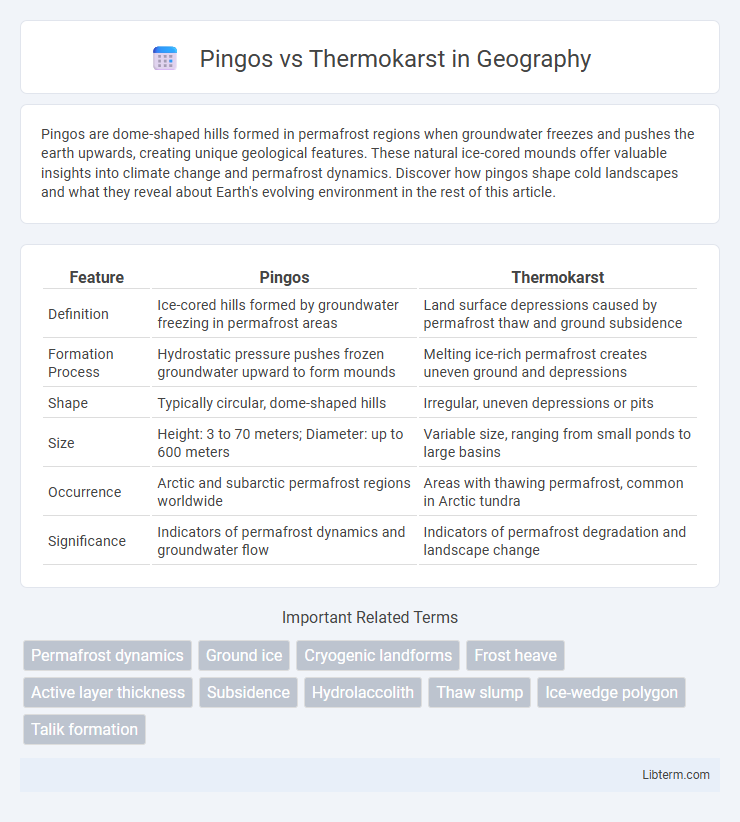Pingos are dome-shaped hills formed in permafrost regions when groundwater freezes and pushes the earth upwards, creating unique geological features. These natural ice-cored mounds offer valuable insights into climate change and permafrost dynamics. Discover how pingos shape cold landscapes and what they reveal about Earth's evolving environment in the rest of this article.
Table of Comparison
| Feature | Pingos | Thermokarst |
|---|---|---|
| Definition | Ice-cored hills formed by groundwater freezing in permafrost areas | Land surface depressions caused by permafrost thaw and ground subsidence |
| Formation Process | Hydrostatic pressure pushes frozen groundwater upward to form mounds | Melting ice-rich permafrost creates uneven ground and depressions |
| Shape | Typically circular, dome-shaped hills | Irregular, uneven depressions or pits |
| Size | Height: 3 to 70 meters; Diameter: up to 600 meters | Variable size, ranging from small ponds to large basins |
| Occurrence | Arctic and subarctic permafrost regions worldwide | Areas with thawing permafrost, common in Arctic tundra |
| Significance | Indicators of permafrost dynamics and groundwater flow | Indicators of permafrost degradation and landscape change |
Introduction to Arctic Landforms
Pingos are dome-shaped ice-cored hills formed by groundwater freezing beneath permafrost, frequently found in continuous permafrost regions of the Arctic. Thermokarst landscapes develop from the thawing of ice-rich permafrost, resulting in irregular surfaces featuring sinkholes, ponds, and subsidence. Both landforms are critical indicators of permafrost dynamics and climate change impacts in Arctic ecosystems.
What Are Pingos?
Pingos are dome-shaped mounds of earth-covered ice found in Arctic and subarctic regions, formed when groundwater freezes and expands beneath the surface. These permafrost features can reach heights of up to 70 meters and diameters exceeding 600 meters, significantly altering local topography. Understanding pingo formation is essential for studying periglacial geomorphology and assessing climate change impacts on frozen landscapes.
Understanding Thermokarst Terrain
Thermokarst terrain forms through the thawing of ice-rich permafrost, leading to ground subsidence and the creation of irregular landforms such as depressions, ponds, and sinkholes. In contrast to pingos, which are mound-like ice-cored hills formed by freezing groundwater, thermokarst features indicate permafrost degradation and landscape instability. Monitoring thermokarst development is crucial for assessing climate change impacts on Arctic ecosystems and infrastructure vulnerability.
Formation Processes: Pingos vs Thermokarst
Pingos form through the freezing and expansion of groundwater trapped beneath permafrost, causing an ice core to push the ground upward into a mound shape. Thermokarst develops from the thawing of ice-rich permafrost, leading to ground subsidence and irregular landforms like depressions and ponds. Both processes are critical indicators of permafrost dynamics and climate change impacts in Arctic and subarctic regions.
Physical Characteristics Comparison
Pingos are dome-shaped ice-cored hills typically found in permafrost regions, characterized by a raised, rounded surface with diameters ranging from 30 to 1000 meters and heights up to 70 meters. Thermokarst landscapes form from the thawing of ice-rich permafrost, resulting in irregular ground subsidence, uneven terrain, and features such as collapsed depressions, ponds, and sinkholes varying widely in size. While pingos exhibit a distinctive convex morphology due to pressurized groundwater freezing, thermokarst topography displays concave, uneven patterns caused by melting ice and ground settlement.
Geographic Distribution and Occurrence
Pingos predominantly occur in Arctic and subarctic regions, such as Alaska, Canada, and Siberia, forming in continuous permafrost areas where groundwater pressure creates ice-cored hills. Thermokarst landscapes develop where permafrost thaw leads to ground subsidence and irregular surface patterns, commonly found in both continuous and discontinuous permafrost zones across northern Russia, Alaska, and Canada. The geographic distribution of pingos is more localized and associated with permafrost stability, while thermokarst features indicate active permafrost degradation and are broadly distributed across variable permafrost extents.
Environmental Impacts and Significance
Pingos are ice-cored hills formed by groundwater freezing, significantly altering local hydrology and vegetation by creating elevated landscapes that affect soil drainage and plant colonization. Thermokarst results from permafrost thaw, leading to ground subsidence, surface water pooling, and disrupted ecosystems, often accelerating the release of greenhouse gases like methane and carbon dioxide. Both features serve as critical indicators of climate change, influencing Arctic carbon cycles and water dynamics, with thermokarst posing higher risks for infrastructure stability and ecosystem degradation.
Indicators of Climate Change
Pingos and thermokarst serve as significant indicators of climate change in permafrost regions; pingos form from groundwater freezing and expanding, revealing stable permafrost conditions, while thermokarst results from permafrost thawing, causing ground subsidence and surface irregularities. Increasing thermokarst activity signals accelerated permafrost degradation, associated with rising temperatures and altered hydrological patterns. Monitoring these landforms through remote sensing and field observations provides critical data on permafrost dynamics and climate-driven environmental shifts.
Challenges in Studying Pingos and Thermokarst
Studying pingos and thermokarst presents challenges due to their remote Arctic locations and the dynamic nature of permafrost landscapes. High-resolution satellite imagery and ground-penetrating radar are essential for monitoring their formation and collapse processes, yet data scarcity and extreme weather conditions limit temporal and spatial analysis. Understanding the interactions between thermal, hydrological, and mechanical factors remains complex, hindering accurate prediction of climate change impacts on these landforms.
Future Outlook for Permafrost Landscapes
Pingos and thermokarst are critical indicators of changing permafrost landscapes, where rising global temperatures accelerate permafrost thaw and alter ground ice dynamics. Future outlooks predict increased thermokarst activity, leading to landscape subsidence and greenhouse gas emissions, while pingo formation may decline as stable ice cores become less common. Understanding these processes is essential for modeling carbon release and infrastructure risks in Arctic regions under climate change scenarios.
Pingos Infographic

 libterm.com
libterm.com